From The Start Of Cross Border E-Commerce To Now In China

The massive population and market size of China have sparked the interest of many international brands and domestic brands, especially in e-commerce. With the advancement of technology and development to the internet, e-commerce has become major GDP (gross domestic product) for China. The creation of e-commerce platforms has also provided many small businesses, consumers, and international business with countless opportunities.

However, to be able to stay rooted in China for any brand and businesses in e-commerce is not easy, despite the large population. The e-commerce industry in China holds complex regulations and policies with a diverging e-commerce ecosystem from other countries. As an international brand with an intent to do cross-border e-commerce trade in China, understanding the history, market trends, political policies and financial insights are the keys to success.
In this chapter, the history and scale of the e-commerce industry in China will help gain insight on the development of the industry throughout to years that have built the ecosystem and the empire that it is today.
20 Years In Making
The e-commerce industry in China have been developing for over 20 years, starting from 1998 with the booming of the digital age. Within the last 20 years, there have been many contributing incidence and developments to the making of the cross-border e-commerce industry in China

In the earliest stages of e-commerce in China in 1998, this period was the beginning for e-commerce and oversea buyers. There were several foreign trading companies in China that begun exploring the opportunities of cross-border e-commerce using the technology of the internet in 1998. One of the companies being Good Orient, which is still operating up to this date, merchandising Chinese style fashion goods across borders. And shortly after in 1999, Jack Ma established Alibaba, one of the largest B2B (business to business) e-commerce platforms in China presently, used for selling goods between factories and manufacturers to companies oversea.
Later in 2002 to 2004, large e-commerce companies from the U.S. have entered the Chinese e-commerce industry, as cross border e-commerce, including eBay in 2002 and Amazon in 2004. At the same time in 2004, many wholesalers begun to export goods internationally through newly established cross border e-commerce platforms such as DHgate. DHgate allows small businesses from all over the world to purchase goods from manufactories from China in bulk, handling all inventories and shipping themselves, differing from the listing system of Alibaba.
In 2005, with the emerging usage and acceptance of internet, many Chinese individuals living abroad away from China in countries such as U.S., Canada and England sell exported goods to families, friends, and consumers with a small markup. These Chinese individuals are called “Dai-Gou” (代购). For instance, during the time when the first generation of iPhone was released in 2007, there would be Daigou living in North America, purchasing and selling the product for consumers, which may have not been available in China at the time.

In the earlier stages of e-commerce, Daigou are international students studying abroad or flight attendants due to the amount of travelling required for their status. As the industry progressed, numerous platforms have become accessible for Daigou to sell products cross-border, such as Taobao.
However, there still remains a large number of Daigou merchandising a variety of exclusive distributed goods or international goods on popular channels such as WeChat, up to this date. This model of e-commerce is suitable for individuals and a temporary solution to bridge the demands of Chinese consumers to a growing brand or business.
In 2007, the rise of Daigou in China have led to the establishment of international C2C (consumer to consumer) e-commerce platform such as Haitao and Taobao Global. Fortunately, Taobao Global and Haitao have expanded rapidly due to the increasing demands, providing numerous opportunities for Daigou and small busineesses to sell goods across the borders to consumers from China.
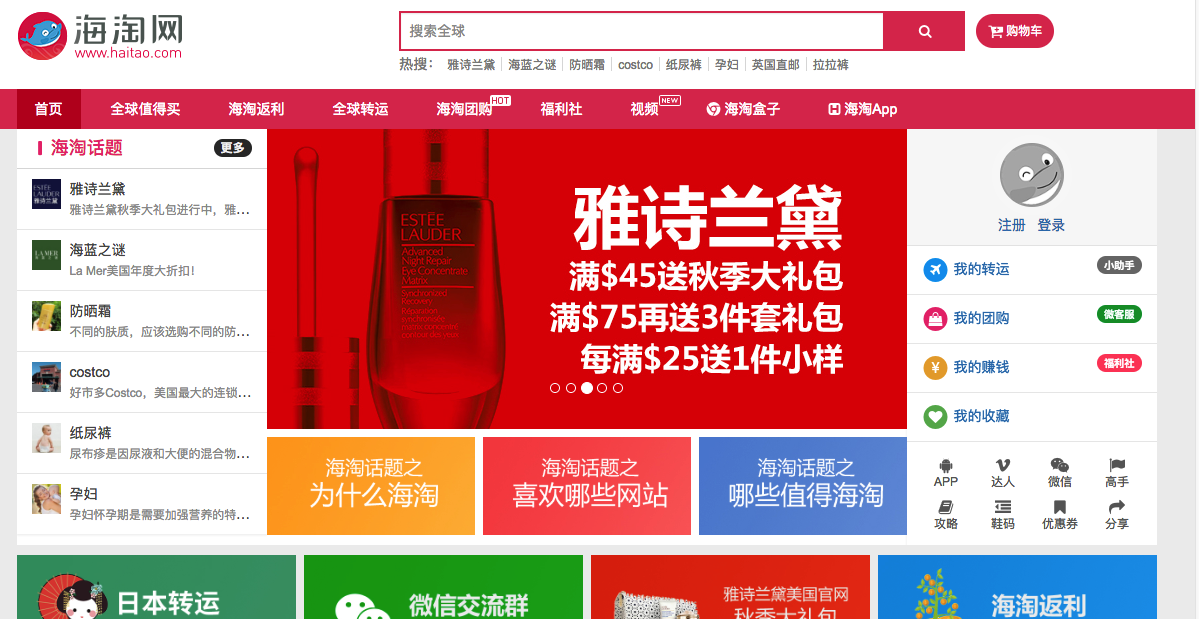
Later in 2009, China have shown an escalating growth in the economy and purchasing power of the consumers. Oversea companies have begun selling goods from manufacturers to Chinese buyers in China, such as Yamatou.
The year 2013 signified the booming of e-commerce and cross border e-commerce in the industry. The adaption of smartphones, internet, and data, the massive boom in e-commerce platforms to meet the demands have also encouraged more consumers to make purchases online. Between 2014 to 2015, there were more than 5,000 cross border e-commerce platform established. To list some of the well-known platforms, Kaola, Vip, Mia, Xiaohongshu.
Another milestone for the development of cross border e-commerce in China was the launch of platforms opened globally for all businesses by Alibaba and Jingdong, Tmall Global and Jingdong Worldwide between 2014 to 2015. The overall retail sales have jumped form $30.1 billion USD to $57.1 billion USD from 2014 to 2015, almost doubling the sales with 90% growth rate in China
In 2016, statistics reported over 42 million Chinese consumers actively engaging in purchases on cross-border e-commerce platforms, which is approximately 82.6% YoY (year-over-year) growth. The numbers of competitors in the cross-border e-commerce platforms have begun to grow and form fierce competitions between all brands. The active development of cross border e-commerce has soon been recognized by the government of China. Within the same year, new regulations and policies have been established in attempt to regulate the importing and exporting of goods in the e-commerce industry in and out of the country itself.
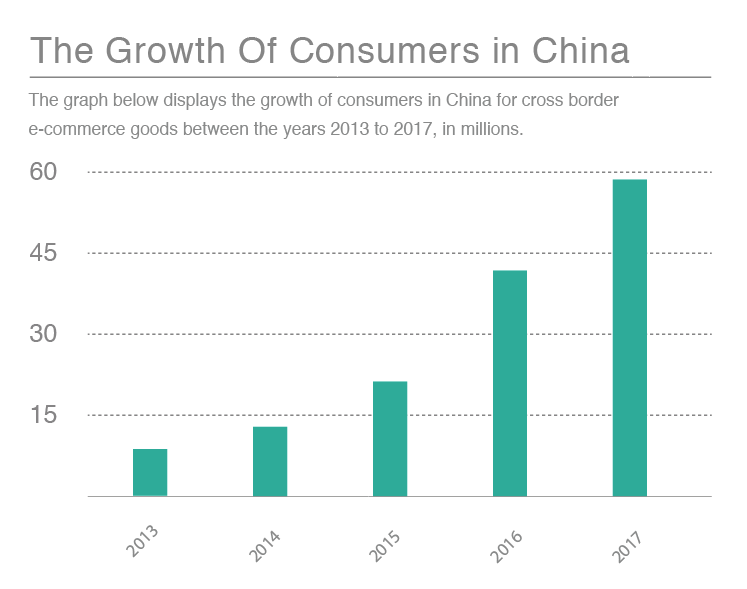
The Big Picture
Observing from the history of e-commerce in China above, there are additional details between the generations, which may impact the decisions to grow or expand in China, and your business. This section will include four different aspects of the e-commerce industry in China that is essential to know.
Market Size
Since 2014 to the present days, the changes and improvements on cross border purchasing tariffs and policies for foreign trade, there has been a tremendous growth on the number of platforms and consumers in China. Additionally, the growing competitions in the industry have also pressurize enhancement to user experience and customer services.
According to iiMedia Research, cross-border e-commerce trading including import and export have reached $945 billion USD in 2016, estimated to reach $1.36 trillion USD by 2018. The importing market in 2016 have also reached 180 billion, which accounts for 20% of the trading totals in 2016.
While cross-border e-commerce is still in its early stages within the e-commerce industry in China, the rate of growth in the market signifies for numerous opportunities to come in the near future.
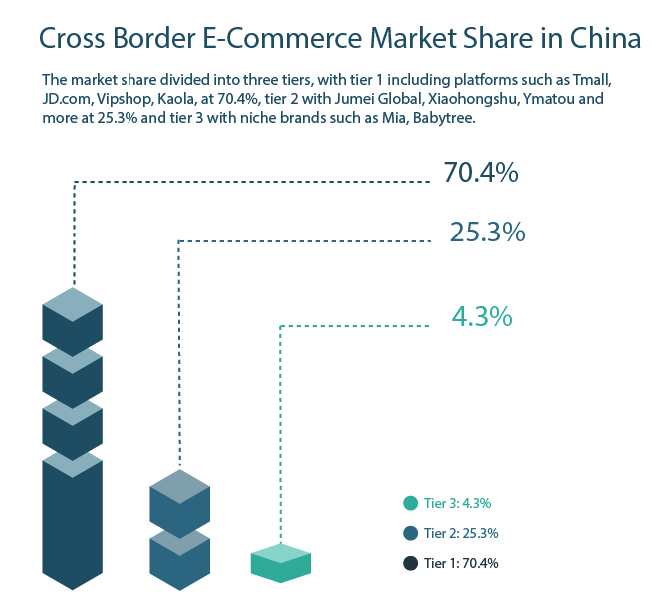
Market Share Analysis
Observing the current market share, the cross-border e-commerce platforms can be divided into three tiers based on the revenue and size.
Tier 1
The top tier cross-border e-commerce groups, the top dogs, in China include Kaola, Tmall, JD.com, and Vipshop with smaller brands merged within. The four platforms account for a majority of the market share, totaling up to 70.4% together. Additionally, the platforms in the tier 1 have the strongest brand presence among all consumers, with loyal customers and numerous resources, such as logistics and customer support. The international market is most definitely within the plan to take part, they are oligopolies in the industry.
Tier 2
The brands in tier 2 include goods in a variety of categories, where you may find platforms merchandising apparel, cosmetics and other FMCG (fast moving consumer goods) as the major revenue. The tier 2 account for 25.3% of the market share in the industry, with brands such as Jumei Global, Xiaohongshu, Yamatou.
Tier 3
The lowest tier in the market account for the remaining 4.3% of the share in cross-border e-commerce in China. These brands included in the tier are Baobeigezi, Mia, Babytree. You may also notice that these brands are specialized on a niche category.
With the growing population in China and a general distrust in infant consumption industry, there is a huge demand for healthy, clean, trustworthy, and reliable e-commerce brand. The demands provided e-commerce brands with opportunities to meet the needs of the population as a reliable source. Thus, most tier 3 e-commerce brand fit into this niche, like Mia, which is focused on infant goods.
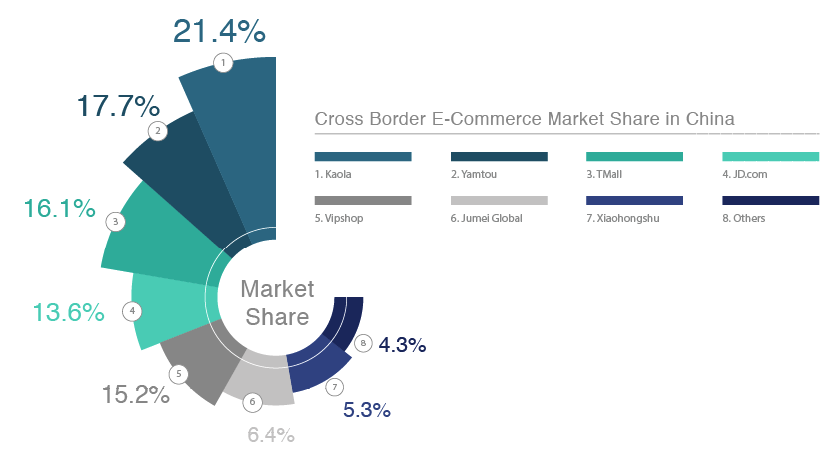
Shifting of E-Commerce Business Model
Another aspect you may have noticed in the history is the shift in delivery of goods. In the early stages of cross-border e-commerce, such as Daigou or eBay is focused on C2C, slowly shifting into a different model over time. However, there are several contributing reasons for this change.
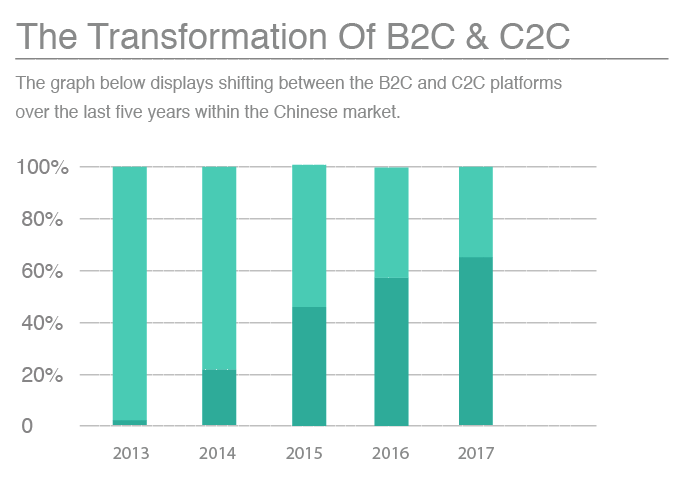
Firstly, the changes in regulations and policies passed by the government of China have contributed to the closure of some C2C platforms and lowering the sustainability of C2C platforms. Secondly, due to the fierce competitions and price wars within the industry, many of the small C2C platforms have merged with larger B2C to sustain. Lastly, the rapid growth of the economy of China have allowed consumers to shift the focus on quality of goods. Additionally, B2C platforms have more capital for better quality goods and customer service over C2C platforms on average. As the industry are developing, the cross border e-commerce and e-commerce market is shifting towards B2C platforms overpowering the C2C platforms.
Conclusion
Some of the major contributing factors to the growth include the increasing usage of internet, improved logistics, regulations to foreign goods, as well as the intense competition between brands driving quality, user experience, and trust. It is expected the cross border e-commerce to account for 24.2% of the consumption totals in China by 2020, also expected to be driven by the several factors known above and new innovative business ideas in the near future to possible surpass the expectations.

 A Complete Guide to Cross-border E-commerce in China
A Complete Guide to Cross-border E-commerce in China


